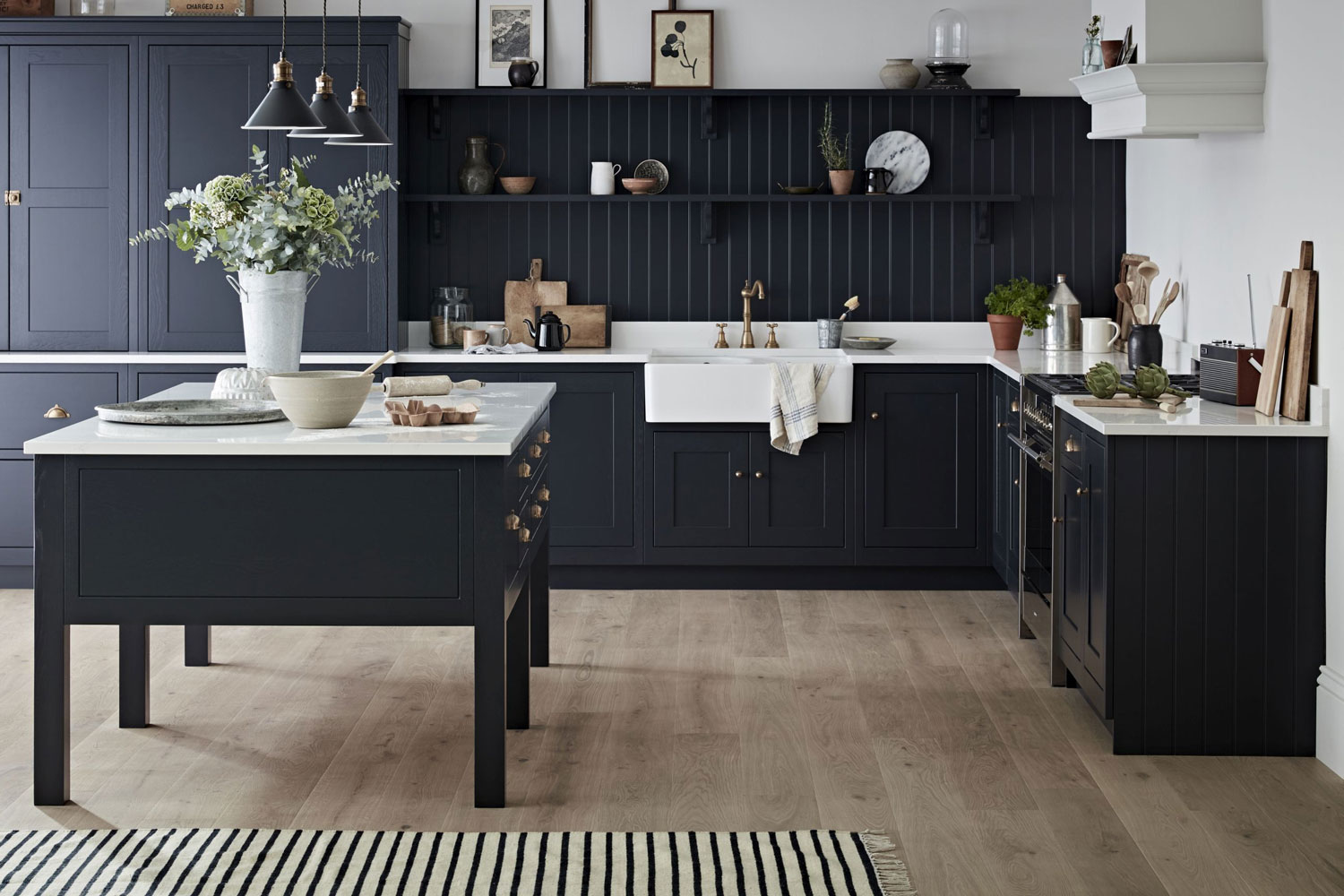How to clean kitchen cabinets – an expert guide
Follow our seven-step guide to cleaning kitchen cabinets so that they smell fresh, look fabulous and are hygienically clean


Knowing how to clean kitchen cabinets like a pro is vital. As the busiest and most popular room of any home, the kitchen is in the spotlight like no other. So, when things get a little grubby, it is hard to miss. Dark colored and high gloss kitchens are particularly prone to emphasizing dust and fingerprints – especially those in south-facing rooms.
But even kitchens with low maintenance finishes in dimly lit spaces benefit from a deep clean every once in a while, for the sake of good hygiene and your own peace of mind.
The dirt levels in any kitchen are exacerbated by the steam from cooking pots and pans, which often contain miniscule oil particles. The most powerful extractor hood can’t stop some of this greasy steam settling on kitchen surfaces. ‘Kitchen cabinets also have high-frequency touch-points, which harbor a lot of germs,’ adds Lynsey Crombie, author and presenter of Queen of Clean. ‘Going over cabinets with a microfiber cloth using just warm water is all it takes to remove sticky marks on a day-to-day basis.’
Regular wipe downs will certainly make life easier when it comes to cleaning a kitchen deeply, which experts recommend should be scheduled at least once or twice a year. For a more comprehensive clean, follow our quick guide and enjoy kitchen cabinet ideas that sparkle from top to bottom, inside and out.
How to clean kitchen cabinets
When cleaning kitchen cabinets – just as with any other similar task – the first step is emptying and decluttering them, and rethinking what they hold, where. Organizing kitchen cabinets at the same time will, after all, make the cleaning more impactful overall.
1. Start at the top

Unless your cabinets fit flush to the ceiling, the very top of wall units is where the worst kitchen grime tends to linger, out of sight and out of mind. However, there are a couple of magic ingredients you can use to remove it – and cleaning with vinegar and cleaning with baking soda are both natural options, too.
You can tackle thick layers of dirt with plenty of natural ingredients so as to avoid the need for harsh chemicals. You can use straight white vinegar and baking soda to form a paste and scrub, or a 1:1 ratio of water to vinegar for an easy, DIY cleaning spray that cuts through grease.
Design expertise in your inbox – from inspiring decorating ideas and beautiful celebrity homes to practical gardening advice and shopping round-ups.
Make sure to dry the area thoroughly when you are done lifting the grease.
2. Empty everything out
Begin with the highest cabinets and empty the contents in a methodical manner that will make it easy to return everything back to its original home. If you don’t have a lot of countertop space to stack items on, you might find it easier to clean kitchen cabinets two or three at a time, but always work from top to bottom.
Take the opportunity to check use-by dates on foodstuffs. If you find two packets of the same ingredient open, and still edible/in date, merge into one packet or decant into an airtight container. If anything is grubby or dusty, clean it as you go. Pop any crockery and glassware not in regular use through a quick cycle in the dishwasher to freshen it up.
3. Clean the interiors of your cabinets

Attach the upholstery nozzle and vacuum each cabinet and drawer out, taking care to get right to the back, into corners and along shelving joints. This will get rid of major crumbs and any dust lurking in crevices.
Next add a few drops of washing-up liquid to a bowl or sink of warm water until lightly soapy. ‘Use a cloth or sponge that’s been in the solution, but not dripping wet, to clean off the grease and grime,’ says Andrew Bramley, owner of professional cleaning business Pure Freedom. ‘Now fill up a new bowl of clean warm water and begin to remove dish soap off the cabinets. Finally, dry down the surface with a towel or microfiber cloth.’
4. Tackle the cleaning of kitchen cabinet fronts
While the surfaces of kitchen doors and drawers are reasonably durable, they do require a gentle approach when cleaning in order to avoid damaging the finish. Laminate doors are probably the most durable, but even they can be scratched without due care. Whatever the finish of your kitchen cabinets, it is crucial to avoid using scrubbing brushes or any other abrasive cleaning tools, as well as cleaning products that include bleach or other harsh chemicals. Also resist spraying liquids directly onto the doors, even plain water, as any streaks or pools of liquid missed when drying may discolor painted and wooden finishes.
The best approach for the fronts of cabinets is to simply use a clean, damp cloth, working from the top of the door downwards in circular motions. If the door is greasy, a small amount of washing up liquid or pH neutral cleaner in water sprayed onto the cloth should be all it takes to shift it. Then a second wipe down with fresh water to make sure any soap is removed. Finally, wipe once more with a dry, microfiber cloth ensuring the surface is dry and smear free.
5. Cleaning glass and mirrored doors

Spray glass cleaner or a mix of white vinegar and water onto a cloth or paper towel before wiping over any glass or mirrored panels in your cabinets. Don’t spray directly onto the glass as the liquid can seep into the framework joints, potentially causing damage or discoloration. Polish to a shine with a dry microfiber cloth.
6. Wipe handles, knobs and hinges
When cleaning kitchen cabinets, don't forget to give cabinet hardware a wipe over with a damp cloth, using a little diluted washing up liquid on any stubborn spots of grease. If metallic hardware is unlacquered – for example antique brass or copper – take care to avoid any cleaning agents that contain lemon or other acidic ingredients as they will quickly discolour the finish. A soft-bristled toothbrush may be useful around the joints of hinges, where dirt and dust can build up, but take care not to damage the cabinet finish in the process.
7. Put everything away again
Once you have cleaned kitchen cabinets, leave them to air dry for an hour or two before refilling them. You may like to place a sheet of greaseproof paper on the base of any cabinets you found particularly hard to clean, such as those hosting treacle, syrup and cooking oils.
How often should I clean kitchen cabinets?
The more you clean your kitchen cabinets, the easier and quicker the chore will become. Aim to give cabinet fronts a wipe down with a damp cloth every week or so, but if you spot a spill or splash, tackle it immediately. A more thorough, deep clean can be done once or twice a year, or you may prefer to tackle one cupboard at a time throughout the year. The main aim is to avoid a build-up of that tacky, grease-based dirt that becomes labor intensive to remove, not to mention unhygienic.
What should I use to clean kitchen cabinets?
‘Dust and grease are never a winning combination and can be a challenge to clean. It may take a little scrubbing but, in terms of cleaning products, a solution of washing up liquid, which is pH neutral so best for wooden surfaces, and the hottest water you can stand will soon have your cabinets looking fresh and clean,’ says Annie McWillam, co-founder of cleaning brand Colt & Willow. ‘Don’t forget a microfiber cloth to finish – the easiest and most effective way to dry and shine.’
Linda graduated from university with a First in Journalism, Film and Broadcasting. Her career began on a trade title for the kitchen and bathroom industry, and she has worked for Homes & Gardens, and sister-brands Livingetc, Country Homes & Interiors and Ideal Home, since 2006, covering interiors topics, though kitchens and bathrooms are her specialism.
